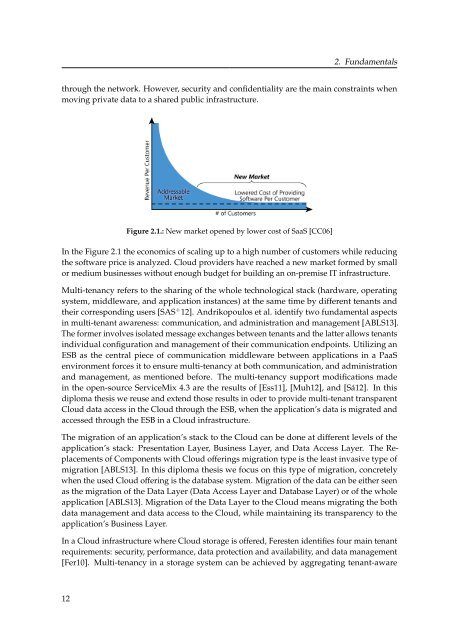Diploma Thesis Santiago Gómez Sáez - IAAS
Diploma Thesis Santiago Gómez Sáez - IAAS
Diploma Thesis Santiago Gómez Sáez - IAAS
Create successful ePaper yourself
Turn your PDF publications into a flip-book with our unique Google optimized e-Paper software.
2. Fundamentals<br />
through the network. However, security and confidentiality are the main constraints when<br />
moving private data to a shared public infrastructure.<br />
Figure 2.1.: New market opened by lower cost of SaaS [CC06]<br />
In the Figure 2.1 the economics of scaling up to a high number of customers while reducing<br />
the software price is analyzed. Cloud providers have reached a new market formed by small<br />
or medium businesses without enough budget for building an on-premise IT infrastructure.<br />
Multi-tenancy refers to the sharing of the whole technological stack (hardware, operating<br />
system, middleware, and application instances) at the same time by different tenants and<br />
their corresponding users [SAS + 12]. Andrikopoulos et al. identify two fundamental aspects<br />
in multi-tenant awareness: communication, and administration and management [ABLS13].<br />
The former involves isolated message exchanges between tenants and the latter allows tenants<br />
individual configuration and management of their communication endpoints. Utilizing an<br />
ESB as the central piece of communication middleware between applications in a PaaS<br />
environment forces it to ensure multi-tenancy at both communication, and administration<br />
and management, as mentioned before. The multi-tenancy support modifications made<br />
in the open-source ServiceMix 4.3 are the results of [Ess11], [Muh12], and [Sá12]. In this<br />
diploma thesis we reuse and extend those results in oder to provide multi-tenant transparent<br />
Cloud data access in the Cloud through the ESB, when the application’s data is migrated and<br />
accessed through the ESB in a Cloud infrastructure.<br />
The migration of an application’s stack to the Cloud can be done at different levels of the<br />
application’s stack: Presentation Layer, Business Layer, and Data Access Layer. The Replacements<br />
of Components with Cloud offerings migration type is the least invasive type of<br />
migration [ABLS13]. In this diploma thesis we focus on this type of migration, concretely<br />
when the used Cloud offering is the database system. Migration of the data can be either seen<br />
as the migration of the Data Layer (Data Access Layer and Database Layer) or of the whole<br />
application [ABLS13]. Migration of the Data Layer to the Cloud means migrating the both<br />
data management and data access to the Cloud, while maintaining its transparency to the<br />
application’s Business Layer.<br />
In a Cloud infrastructure where Cloud storage is offered, Feresten identifies four main tenant<br />
requirements: security, performance, data protection and availability, and data management<br />
[Fer10]. Multi-tenancy in a storage system can be achieved by aggregating tenant-aware<br />
12

















